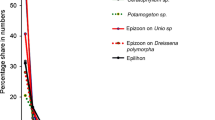Abstract
In the northern part of Lake Peipus, 140 taxa of rotifers were identified, with species of Anuraeopsis, Conochilus, Keratella, Polyarthra and Synchaeta dominating. Two main periods of sexual reproduction occur, in the spring and autumn. Different life cycle patterns are represented. Rotifer number and biomass have two maxima between spring and early autumn. The contribution of rotifers to total zooplankton production varies from 13.6% (Oct.) to 89.8% (May). The average production of grazing rotifers is 485.1 kJ m−2, while that of predatory rotifers (Asplanchna) is 10.0 kJ m−2.
Similar content being viewed by others
References
Haberman, J., 1990. Production of zooplankton in Lake Peipsi. In T. Timm (ed.), State of Lake Peipsi. Eesti TA, Tartu: 115–118. (in Estonian, with English summary).
Ivanova, M. B., 1985. Production of planktonic crustaceans in fresh water. ZIN AN SSSR, Leningrad, 222 pp. (in Russian).
King, C. E., 1980. The genetic structure of zooplankton populations. In W. C. Kerfoot (ed.), Evolution and Ecology of Zooplankton Communities. The University Press of New England, Hanover (N.H.): 315–328.
Kutikova, L. A., 1970. Rotifers of the fauna of the USSR. Nauka, Leningrad, 744 pp. (in Russian).
Lindpere, A., H. Starast, A. Milius, M. Haldna & H. Simm, 1989. Water characteristics of Lake Peipsi-Pihkva in 1985–1987. Proceedings of the Academy of Sciences of the Estonian SSR. Biology 38: 107–118. (in Estonian).
Nxxoges, T. H., 1989. Ecological relations of the main plankton components in the pelagial of Lake Peipsi. Abstracts of the candidate thesis. Moscow, 17 pp. (in Russian).
Nōges, T., P. Nōges & I. Ott, 1989. Phytoplankton production in the pelagial of Lake Peipsi in 1985–1986. Proceedings of the Academy of Sciences of the Estonian SSR. Biology 38: 123–130. (in Russian).
Odum, E. P., 1959. Fundamentals of ecology. Saunders, Philadelphia, 546 pp.
Ruttner-Kolisko, A., 1977. Suggestions for biomass calculation of planktonic rotifers. Arch. Hydrobiol. Beih. Ergebn. Limnol. 8: 71–76.
Starast, H., A. Lindpere & A. Milius, 1990. Methodological recommendations for the estimation of the trophic state of Lake Peipsi. In T. Timm (ed.), State of Lake Peipsi. Eesti TA, Tartu: 16–19. (in Estonian, with English summary).
Virro, T., 1989. The comparison of sampling methods of planktonic rotifers (Rotatoria) on the example of Lake Peipsi. Proceedings of the Academy of Sciences of the Estonian SSR. Biology 38: 119–122. (in Russian, with English summary).
Waters, T. F., 1977. Secondary production in inland waters. Adv. ecol. Res. 10: 91–164.
Winberg, G. G. & G. M. Lavrentyeva (eds), 1984. Methodical recommendations for collection and analysing materials of hydrobiological studies on fresh water reservoirs. Zooplankton and its production. Leningrad, 33 pp. (in Russian).
Author information
Authors and Affiliations
Rights and permissions
About this article
Cite this article
Virro, T., Haberman, J. The rotifers of Lake Peipus. Hydrobiologia 255, 389–396 (1993). https://doi.org/10.1007/BF00025864
Issue Date:
DOI: https://doi.org/10.1007/BF00025864




